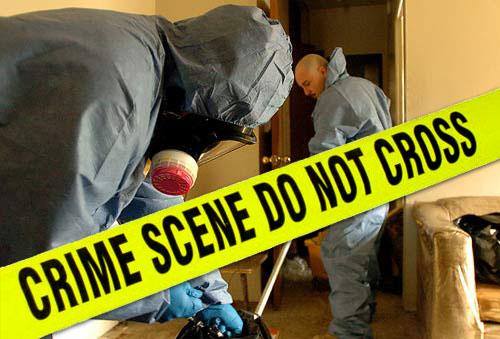⋅Real Life Scene – Decomposed Body⋅

It’s not anything like what you see on TV. Dead and decomposed bodies aren’t anything like the beautiful actors who have just stepped out of a dressing room in their pressed, clean, unblemished clothes, perfectly styled hair, flawlessly applied makeup, now smartly and carefully posed in glistening pools of blood that somehow haven’t sprayed all over the walls, furniture, carpet, and victim’s perfectly matched and unstained clothes, and haven’t even begun to coagulate and turn to goo. Even more remarkable are the scenes in which the actor was shot through the head, which is still completely intact with perfectly styled hair and a barely blood-stained wall behind it.
Exactly what does a decomposing body look like?
Ever wonder what it’s really like?
My job is cleaning up after the real murders, suicides, and other violent deaths, so I can tell you with absolute certainty that not a one of them in my entire 20+ year career bears any resemblance to what you see on TV. If it did, we wouldn’t have to dress like this just to enter a death scene.
Worst of the Worst
One of the most common – and most horrific – events we are called in to clean up is an unattended death, which means the body was discovered after decomposition was well under way.
Only two to three days after death, less if the body is in a very warm room, the body is in an advanced stage of decomposition called “putrefaction” in which the body is swollen, has a greenish hue, is infested with maggots that have burrowed into the corpse and are consuming it, and has often burst open from the build-up of internal gasses.
The coroner has usually removed the decomposed body by the time we get there (but not always), but large quantities of liquefied matter from the body, along with maggots, cover the area where the body had lain. Because a decomposing body’s lungs emit copious amounts of fluid through the mouth and nose, those fluids are also present in the area where the body had lain. All of this bio hazardous material must be thoroughly cleaned and professionally removed.
Assault on the Senses
One thing the coroner can’t remove is the unbearable stench, which permeates the walls, flooring, drapery, furniture, and the very structure of the home itself and which requires cleaners to wear ventilated respirators.
Because decomposition produces many gases, including hydrogen sulfide, which is what causes rotting eggs to smell so bad, the overwhelming smell of a decomposing body is similar to rotting eggs.
But imagine an entire 150-pound human body, not just one small egg, that smells this way.
Along with the cleaning up the liquefied remains and body fluids and using special equipment and chemicals to deodorize the environment, we must find and kill any maggots that escaped the body and the immediate area where the body lay and are now running around the environment carrying deadly pathogens with them.
A Job for the Professionals
This is clearly not a job for the squeamish – or for handsome actors with perfectly groomed hair who can evaluate a black and bloated corpse oozing unidentifiable goo, ungloved and unmasked, while they munch on a tuna sandwich and chat with their girlfriends on their iPhones.
Leave hard-core, real-death cleanups to the experts. Advanced Bio Treatment professionals have no delusions about what they are walking into.
We’ve seen it all, we’ve cleaned it all, and we come prepared to do the job thoroughly, professionally, respectfully, and safely.
We follow all OSHA, EPA, and state health department guidelines to make the environment safe and livable for others.
